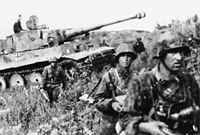
The Battle of Kursk begins. It features the largest tank engagement in history.
Following their catastrophic defeat at Stalingrad five months earlier, the Germans lacked the strength to attack the entire eastern front. The high command focused instead on a salient close to Kursk in Russia, near Ukraine. There was an opportunity there to encircle and destroy a dozen Soviet armies. After that, the Germans planned to strike northward at Moscow. The operation, about which even Hitler expressed misgivings, was code-named Zitadelle, or Citadel.

The Germans committed nearly a million men, 2,700 tanks, and 2,000 aircraft to this attack. They would face a Soviet force of 1.3 million men, 3,600 tanks, 2,400 planes, and more than 20,000 artillery pieces.
The Battle of Kursk was the apogee of tank warfare (see here). The Soviets were equipped with probably the war’s most consistently efficient tank, the T-34, which had given the Germans a nasty shock early in the eastern campaign. Germany’s tanks (called Panzer in German) were also excellent—at least on paper. Their Panther tank had been designed specifically to take on the T-34.
The decisive engagement was fought July 12 at Prokhorovka, with German and Soviet tanks blasting away at point-blank range. Although the Soviets suffered considerably heavier losses, overall German strength was ebbing fast. With the Allied invasion of Sicily on July 11 and a new Soviet offensive beginning in the north, Hitler called off Zitadelle on July 13. Kursk was where the operational initiative on the eastern front passed to the Red Army. Germany could no longer dictate the course of war to an enemy that was only growing in strength. With the country’s dwindling forces being siphoned off to meet threats in other theaters, Germany’s fate was sealed.—TL